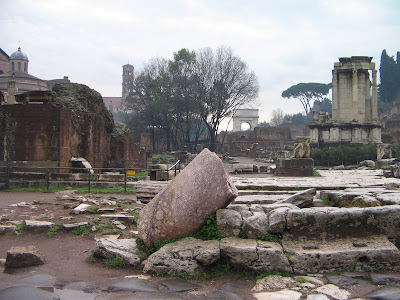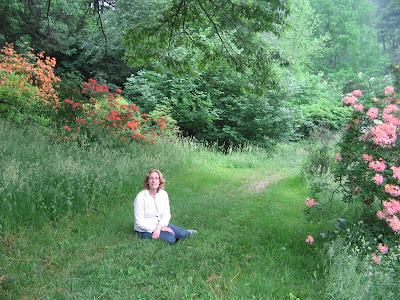



If the visitor is organized she will have arranged to stay at Casa Sanctissimo, Altissimo, and Really Nice Guy Paolo, a villa on the southwestern outskirts of town. As we enter Casa Paolo, we are struck by the graceful height of the ceilings, the comfortable sense of space, and the airy light flooding the loggia. This last characteristic comes from a narrow terrazza along the north border of the residence, a requisite comfort among the Roman elite.

Note the splendid marble floor, and the antique oriental tapestry. In moments of privacy, the visitor may use either one for a few yoga stretches. Most of the furnishings are contemporary Swedish, no doubt in homage to Queen Christina of Sweden, who abdicated in 1654 and moved to Rome, where she was feted for months by Pope Alexander the VII with elaborate celebrations.

The Porta del Popolo, redecorated by Bernini with the Chigi coat of arms, to celebrate the entrance of the Queen. Felici faustoque ingressui, it says: for a happy and blessed entrance.




If our visit is during the winter we must acclimate ourselves to an environment very different from the summer months. In high summer, the heat is like a constant, generous travel companion, never leaving us, embracing us wherever we are. Now, the surprisingly frigid air goes straight through our clothes and cold sunshine melts into winter darkness at an early hour. Fortunately, a bit of the excitement of the holidays lingers in the air, and the streets bustle with more Romans than tourists.
We eventually push off to our dinner appointment with the indefatigable Sarah, our lively English friend who has been teaching in Rome for several years. Past the Colosseum, over the Celian hill, up some steps and behind a door with a broken bell we find Sarah’s flat. She has impossibly light blue eyes and will give you a hug that cuts off your circulation. During the meal we marvel at how her Italian has grown- three years ago she couldn’t roll her r’s, now every word gets a trrriple rrrrrr! Nonetheless, her Italian is easier for a foreigner to understand than her strong York brogue.
The next morning, we set off from Casa Paolo on our own. Hopefully he has given us keys to the apartment, which resemble something that might have opened your Grandmother's lingerie closet:


If the visitor is tall, blonde, and/or female, she will likely be regarded as a rock star. Live it up. While difficult for foreigners to become accustomed to, the attention actually invigorates, making us feel like a walking piece of art. After a few minutes we arrive at the magnificent "Spanish steps," replete with loitering "businessmen" at midday.

 The central post office, in a restored villa.
The central post office, in a restored villa.A winter visit is the best time to acquaint ourselves with the famous winds of Rome. If we were here once in summer, we are already familiar with the sirocco, the sandy heat blasts that sweep up from the Sahara. In winter, we can expect to encounter the tramontana, bringing rain and cold northern air from the Rhone Valley. On fair days, the air is swept free of clouds, and frames the city in picture-perfect colors and shadows.

On one visit to the ruins we are ogled by a man. He could be 40, he could be ageless, a condition mastered by so many Italian men. Eyeing your blonde hair (after surveying your midsection and behind), he hesitates to greet you in his native tongue. He begins the guessing game: Are you from Norway? Germany? England? We go through all of Europe. Americana? Si. Pause. Do you like Rome? Si. Ciao.
We spend our days as before, traversing layers of history and style, accompanied only by the tramontana, our own will, and the murmurs of the locals, who take to the streets for the after-Christmas sales. And it's all just so wonderful.
Or it's not. You stuff your guidebook and umbrella in your purse, which is too small for all your things, and you walk around with your hands stuffed into your autumn jacket, which fails to warm you against the cold. But is it not a joy, you think to yourself, to be here again? To take the same pictures, to eat the same gelato (now slightly stale in the off season), to see the same exhibit you saw years ago, to walk the same streets, if only this time you are even more out of place as an out-of-season tourist, and even more lonely as you wonder why you chose to spend time away from your loved one, even if it meant an encounter with beauty. Everywhere, we are confronted by the purposeless of the journey, and reminded of the places where once we were greeted with kisses, but now we can expect only closed doors.


But if it's humanity you want you need look no further, as you also will be keeping company with la bella Cinzia! Cinzia, a mystery writer, resembles a delicate, rare bird. She lives in the Palazzo Barberini.
Up these stairs - the Borromini stairs - we encounter Cinzia's sumptuous apartment, which she shares with her husband Giovanni. The two welcome you as if you had never left, with rich pasta and cordials and conversation. After paying respects to Janus, the two-faced god in the palace's newly restored hanging gardens, we set out on our way refreshed and invigorated.
The days pass and we find ourselves with much too much time and not nearly enough. There are people to visit, but the visits are shallow and contrived. For although all past acquaintances indeed welcome you again, your sporadic emails and limited language skills do not a friendship make, and after your brief appearance, you will once again fall into internet obscurity. After a few awkward encounters, we limit ourselves to our more forgiving friends, or we pass the days alone.
But there's a break in the rains to revisit an old site, the magnificent Santa Maria Maggiore, whose origins as a papal basilica date to the 4th century, on ground that was sacred to Romans for millenia. The early Christian mosaics on the apse are indescribable, like a glimpse of the heavens themselves, and merit return visits again and again. Only this time we arrive too late, and the apse is no longer illuminated, and the church is being used for a few evening prayers before closing. We can only glimpse through the gloom and use our imagination. We had a similar experience trying to see the Pinturicchio frescoes at the Santa Maria del Popolo.
Again we tire of our own company and we chose to spend time with the lively family we knew those years ago. Their 4-year-olds are now world-weary boys of seven, and they scarely notice you as they slink off to the television set while you chit chat with the parents. Again, regrettably, we have an encounter that neither satisfies our need for a human touch, or illuminates us with a revelatory tourist experience. But perhaps there is one thing we can take away from our boring evening with the fam:
A creche. A family creche. Families traditionally keep a creche in their homes until epiphany, just like catholic churches do. The family creche is dying even in Catholic Italy, but this family's is nonetheless immense, replete with running water and a train.
Another greeting, another parting, and we are back on the streets, making our rainy way back to Paolo's to collect our things and return to Paris, beginning the long leg of the journey home.
Roma, una vita non è basta! True. It would take millenia to truly know the city in depth, from the highest terrazza to the lowest pebble of ruins. But a meandering trip - where friendships were once sunnier, where high ramparts that were once open to you are severely shut, where the flickers of connection are too easily extinguished by distance - serves only to sadden you. We depart like a ghost, unable to truly relive our sunny past, but backing in the glowing remains of the beauty we remember, and open-ended friendships.











No comments:
Post a Comment